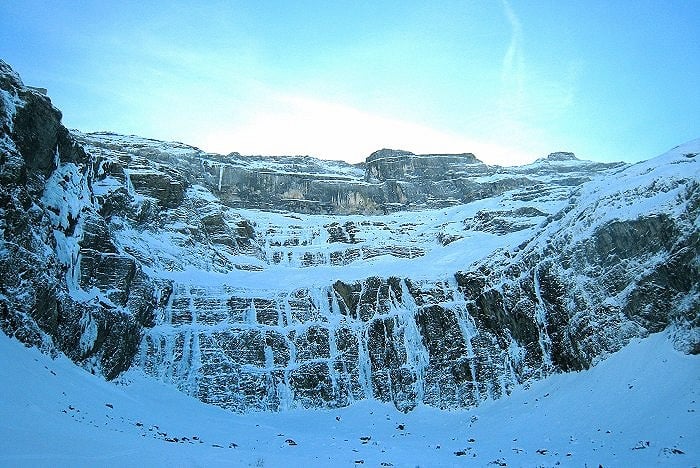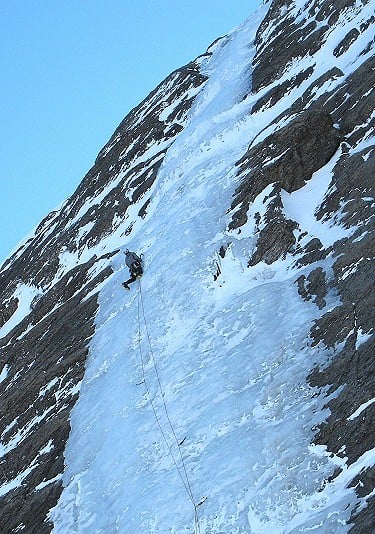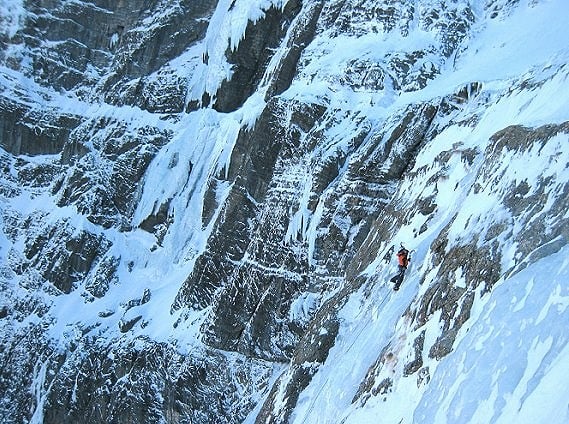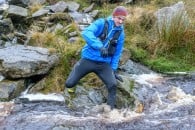Icefall climbing in mainland Europe is becoming increasingly popular, with venues such as Chamonix, Cogne and La Grave getting busier and busier. When I was invited to visit the French Pyrenees to sample the icefalls of the Cirque de Gavarnie, I was intrigued. I asked around and spoke to a couple of Brits who had been there, but neither of them had climbed. Either there had been lots of snow fall and the avalanche danger had been too high, or it had been very warm and little was in condition. The place seems to have a bit of a reputation, and is a playground of Basque climbers who nip across the border each winter. 
The village of Gavarnie is located in the heart of the French Pyrenees and is easily reached from the travel hubs of Pau or Toulouse. The base of the Cirque de Gavarnie is at 1,500m and is completely north facing. It is split by two large terraces to form three levels of icefalls. The lower level is 300 – 350m high or 6 long pitches. The routes are sustained and start at WI4, with most of them in the WI4+ - WI5 range. Access to the upper levels is either by being very fit and fast, or, by skiing in from the hut, which is located high on the west aspect of the cirque. To do a route on all three levels requires that you get up very early - enchaining three routes routes would involve 1,500m of relief with 750m of climbing.

The walk into the cirque takes between 1 and 1.5 hours and is fairly level. It's normal to get up very early and get to the base of the routes for first light, as the icefalls are long and you can get that afternoon thawing feeling. We climbed one route each day - a combination of Cascade des Banzayous and Dopamine (both WI4+) on the first day and the mega-classic Ice Folle (WI4+) on our second day.
There are two equipped abseil descents to get off the routes, the right-hand one of which (looking out) is poorly positioned. The left-hand one descends just to the left of the route, Fluide Glacial. Approaching the first anchors involves down-climbing steep snow from the terrace – be careful! Few of the routes have any fixed belays, so make sure you take enough ice screws to lead a 60-metre pitch and belay!
VIDEO:Ice climbing Cirque de Gavarnie
There's no question that the Cirque de Gavarnie has a great atmosphere and a bigger feel to a lot of the 'convenient' cascades that are popular in Cogne, for example. If you are looking for a change after a couple of days walking into the cirque, an hour and a half away is another small mountain resort called Gourette. Here you can take a chairlift up to 2,000m and do some mixed routes on the Pene Blanque (there's the odd fixed peg, but take stubby ice screws) or the Rognon de Ger. The Rognon de Ger offers 300m goulottes with a real 'mountain' feel to them and they are only 20 minutes from the lifts!
Season
Conditions in Gavarnie are usually best in late December through to March. This past year early January was very good with classics such as Thanatos in condition. I climbed in the first week in February and there was way more ice than in La Grave in mid-January!

Where to stay
Luz St Sauveur is the best place to stay unless you are parking up your campervan at the start of the trail into the cirque. Gavarnie itself is very quiet in winter. Luz is 25 minutes from where you park up to walk in. The old part of town is very beautiful and has a 12th century church. There are some good bars (try La Tasca), a decent-sized Champion supermarket and even a bowling alley! Accommodation is easy to find in winter, from a bunkhouse at the cheap end of the market, to superb rooms in 18th century town houses. Visit www.luz.org and get in touch with the Tourist Office.
Les Cascades Gite d'Etape 05.62.92.94.14 (24 Euros Half Board dorm)
Hotel des Cimes www.hoteldescimes.com (40 Euros Half Board Twin)
Getting there
The village of Luz St Sauveur is 30 minutes from Lourdes, 1.5 hours from Pau and 2 hours from Toulouse and Biarritz. Easyjet and Ryanair fly to Pau/Toulouse/Biarritz. Lourdes has good train links direct from Paris or from Toulouse. Pyrenean Mountain Tours can arrange transfers from Lourdes.
Useful Travel Links
www.eurostar.com
www.easyjet.co.uk
www.ryanair.com
www.pyrenees.co.uk


Guidebook and websites
Gavarnie Cascades de Glace (2003 edition) by Jose Isidro Gordito and Joan Quintana
(available from www.needlesports.com)
www.ice-dreams.com
www.webcam-gavarnie.com (Check the conditions!)
Jagged Globe Pyrenean Ice – Gavarnie
Next winter Jagged Globe are organising intermediate ice climbing courses in Gavarnie. These courses are accommodated in a superb hotel in Luz and are directed by IFMGA Guide, Richard Dupont. Richard has lived in Luz for the past 20 years and has put up some of the harder routes in the cirque. He also works for Jagged Globe on their summer Alpine Courses. For more information, visit:
www.jagged-globe.co.uk/course/itinerary/alps+ice_gavarnie
Map



Comments